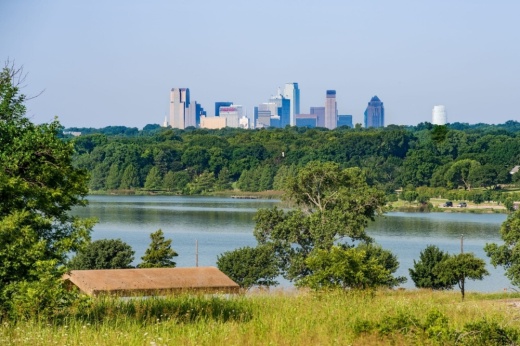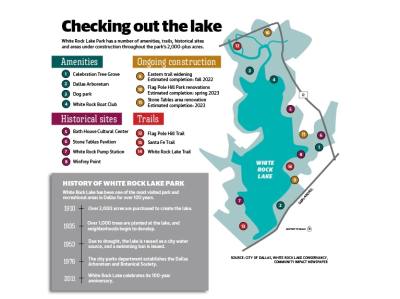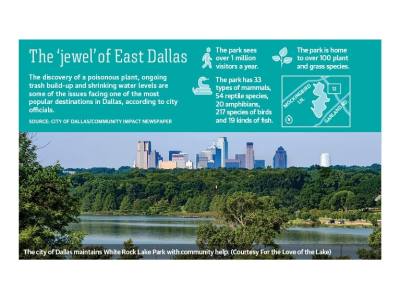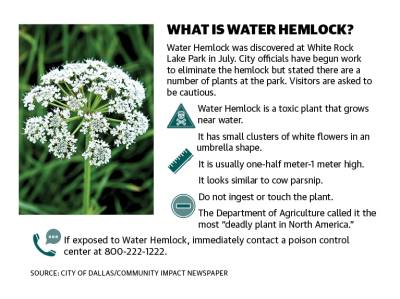The nearly 2,000-acre park is one of the most popular in Dallas, according to city officials. The city’s website states it is one of the best places to experience natural areas and wildlife in Dallas.
However, water hemlock, a toxic plant that grows in wet areas, was identified at various points around the lake this summer. According to a July 21 release, city staff began destroying the invasive species after its discovery. Ben Heistein, area-manager for Dallas Parks and Recreation Department, said getting rid of the hemlock is a top priority because the park “has thousands of visitors a day.”
In the past several years, the lake has seen support from the city as well as the local community. For the Love of the Lake, a local nonprofit dedicated to lake upkeep, also works to maintain the park for visitors. The company organizes regular cleanup events where volunteers pick up trash in and around the lake to preserve the area’s beauty.
Aside from being a visitor attraction, White Rock Lake is surrounded by a number of neighborhoods, including Lakewood and Lake Highlands. According to the city’s website, the lake receives more than 1 million visitors per year and is vital to the economic success of East Dallas.
“Because [White Rock Lake Park] is one of the new natural resources in the city, we try to strike a balance to maintain it as a top-notch park for recreational access and enjoyment,” said Heistein. “At the same time, we want to preserve the environment and encourage native plants and wildlife to flourish as much as possible.”
A dangerous plant
According to the National Poison Control Center, ingesting water hemlock can cause severe toxicity and death in humans and animals. The U.S. Department of Agriculture has called the plant the most “deadly in North America,” with reports that the plant’s toxins can shut down a person’s or animal’s central nervous system in a half-hour or less. The plant can also be toxic through skin contact but is most dangerous when ingested.
According to the city’s release, the water hemlock plant grows in wetter locations and is usually one-half meter to 1 meter in height. It has small clusters of white flowers in an umbrella formation and may resemble common yarrow or cow parsnip.
The release stated the city will typically use nonchemical methods to remove an invasive plant species. But because of the toxicity of hemlock, hand-pulling or mowing the plant is too dangerous for city employees and could cause inadvertent exposure. Parks department crews are using the herbicide Rodeo, which is approved for use near aquatic environments, to destroy the hemlock.
“Right now, it looks like our pesticide treatment was effective, and we are seeing the hemlock die off,” Heistein said. “We are monitoring to see if an additional application is warranted.”
The city has not had any reports of someone coming into contact with the plant, but Heistein said there is still concern because of how popular the lake and its trails are among visitors.
“There’s definitely a risk of people coming into contact with it,” he said. “The lake gets thousands of visitors every day. We were alarmed by how much [hemlock] there was ... so we took pretty quick action.”
Heistein said the hemlock could be found in discreet spots on the lake’s eastern and western shores, away from the common trails. He said crews found various clusters of hemlock at about 200-foot intervals. From shoreline to shoreline, White Rock Lake is estimated to be 1,015 acres, according to the city’s website.
As dangerous as hemlock can be for people, Heistein said there is often a greater risk to animals, dogs in particular. Many lakegoers bring their dogs with them to the park, which can pose a risk. Parks department officials are continuing to monitor hemlock at the lake and encourage anyone who may come in contact with the plant to call a poison control center immediately.
“The good thing is, most of it was 30-50 feet off the path, so to come in contact with it you’d kind of have to bushwhack off the [trail], which is pretty unlikely,” he said.
Working together
Trash buildup at White Rock Lake is another issue city officials and community members are working on solving. Since For the Love of the Lake was established in 1995, it has been organizing trash cleanup events around White Rock Lake Park to combat buildup. The nonprofit works closely with city staff to identify ways they can assist with the lake’s maintenance and upkeep.
The organization has held Second Saturday Shoreline Spruce-ups since the nonprofit first began, during which volunteers meet at the lake and spread out to clean trash in and out of the water. According to Z. Zsohar, For the Love of the Lake’s board president, the monthly cleanup event has occurred 317 consecutive times.
“We have all these programs, and we work closely with the [Dallas Parks and Recreation Department] so we can keep the lake clean and pristine for everyone,” Zsohar said. “We haven’t missed a second Saturday since we started. We have had snow storms [and] torrential rains, but we always have volunteers show up.”
Zsohar said much of the trash can be attributed to the various streams and creeks that feed into the lake from as far north as Plano and Frisco. The currents bring the trash down the streams and into White Rock Lake, where it builds up along the shorelines.
According to data provided by For the Love of the Lake, the nonprofits volunteers and members provided 13,000 hours of volunteer labor in 2021. Dallas officials estimated this amount of labor would have cost $326,430 to the city.
“It really helps to have community partners to shoulder some of the workload out there, and that exists because people love the lake so much,” Heistein said.
To help preserve that environment, in 2021 For the Love of the Lake volunteers collected an estimated 400 cubic yards of trash. Through July of this year, the organization estimates it has collected 299 cubic yards of trash at a value of $225,000 of free labor.
The nonprofit also organizes special group cleanup events where schools, companies or other organizations can schedule a time to pick up trash at a designated area off the lake. For the Love of the Lake will provide trash bags, trash grabber tools, canoes and more for volunteers to assist with trash pickup. The nonprofit also partners with various organizations to sponsor 50 different sites around the lake for regular trash cleanup.
“It is everybody’s lake, and we want people to enjoy it,” said Zsohar. “It is the jewel of the city. We will do anything we can to keep it clean and pristine for future generations.”
Protecting the lake
In addition to community support, funds to help further improve the lake could be on the horizon. The city of Dallas is proposing a $1 billion bond program for the May ballot in 2024. If that bond passes, funds could be allocated to complete a dredging of White Rock Lake, according to Dallas Parks and Recreation Department officials.
Dredging is the process of removing accumulated rocks, dirt and sediment from a lake to restore depth and maintain water quality, according to the White Rock Lake Dredging Feasibility Study. The study was done in 2020, and it estimates the cost of dredging could be anywhere from $32 million-$88 million.
District 9 Council Member Paula Blackmon has emphasized that protecting and improving White Rock Lake is one of her goals. She said in a city memo that White Rock Lake must be dredged to maintain the lake’s integrity and ecosystem.
“It has been over 20 years since White Rock Lake has been dredged, and currently the silt accumulation can be up to 7 feet thick in some locations,” Blackmon stated in the memo. “We are seeing more wetlands created because of this accumulation; the water quality and surrounding ecosystem are hitting critical levels. White Rock Lake is in desperate need of maintenance and care.”
No exact timeline has been announced on the dredging, but parks department officials estimate it could take up to four years to begin work if the funds were made available via the 2024 bond.
A 15-member citizens bond task force is expected to be appointed by next summer to help develop project and infrastructure proposals for the potential 2024 bond funds, according to a July city release. City officials stated residents are encouraged to contact the task force or local council members to provide feedback on the proposed bond and how its funds should be allocated.








